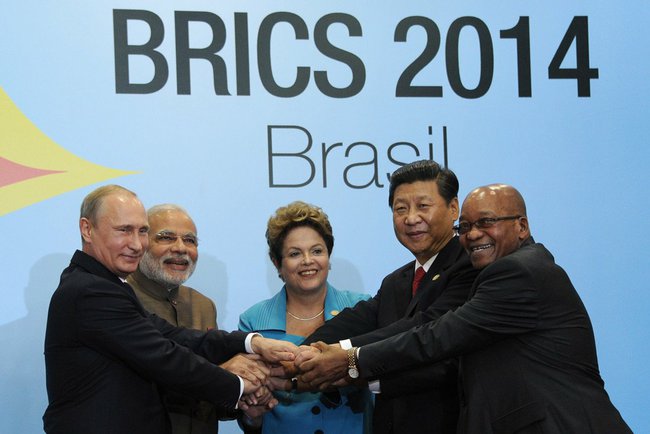
This article was originally published by the East Asia Forum on 2 August 2014.
The BRICS countries met for their sixth annual summit in Brazil this month, setting out to establish a counterweight to Western-dominated global financial institutions.
The summit’s key achievement was the establishment of the long-awaited BRICS New Development Bank. The bank will press for a bigger say in the global financial order — which is centred on the IMF and the World Bank. While China won the race for the bank’s headquarters, set to be located in Shanghai, India secured the presidency. The bank is a sign of the growing influence of the BRICS which together account for 18 per cent of world trade, 40 per cent of the global population and a combined GDP of US$24 trillion.
The new bank is based on the much-discussed vision of ‘equality and fairness’. Its initial US$50 billion in capital will be provided equally by its five founders, thereby creating an equal shareholding.
Another significant achievement at the summit was the setting up of a US$100 billion currency reserve pool, the Contingent Reserve Arrangement. To this end, China — the holder of the world’s largest foreign exchange reserves — will contribute US$41 billion, with a further US$18 billion each from Brazil and India, and US$5 billion from South Africa.
The New Development Bank is designed to compete with the IMF and World Bank by making the bank accessible for developing countries and financing their infrastructure projects. It will help countries forestall short-term liquidity pressure and guard against crises. Compared to the World Bank, the new development bank plans to grant loans with fewer restrictions and shorter delays. Yet it may also be careless in selecting projects and this could threaten the bank’s sustainability.
The Contingent Reserve Arrangement will also compete with the IMF, which failed to initiate necessary reforms during the global financial crisis. At the BRICS bank, lending will be based on a simple majority voting system which will grant the member nations the right to borrow loans of up to 30 per cent during liquidity crises.
The new bank is a major achievement for the representation of emerging market economies on the international stage. The Western-dominated IMF has long failed on this front. Draft reforms to increase developing countries’ voting power by even 6 per cent were not adopted after failing to receive US support.
Still, some of the New Development Bank’s member countries, especially India and Brazil, fear China will assert greater influence over the bank in order to amplify its influence abroad as the world’s second largest economy.
Yet, for India’s new prime minister, the BRICS summit proved a productive springboard for the airing of bilateral, regional and international issues in a ‘freewheeling’ 80 minute discussion with China’s President Xi Jinping. Xi invited Modi to attend the coming APEC summit in Beijing to work together on international platforms and pressed for India to increase its involvement with the Shanghai Cooperation Organization (SCO).
Modi discussed the need for more Chinese FDI in India’s infrastructure sector and stressed the growing trade imbalance between the two countries. In turn, Xi expressed a willingness to open China’s market to Indian services exports. The two leaders also sought a negotiation on the Sino–Indian border dispute which is seen as a major stumbling block in the relationship.
The summit was also a chance for Modi to discuss the worsening issue of terrorism in the region. The situations in West Asia, as well as the developments in Syria, have caused serious concern in India. With this in mind, Modi made a pitch for reforms in institutions such as the UN Security Council and IMF to promote global governance.
Compared to the success of the China meeting, Modi’s meeting with Russia’s President Vladimir Putin was a missed opportunity. With the scheduled meeting being replaced by a hurried 40 minute chat, the two leaders did not discuss the US$40 billion India–Russia pipeline project. But Modi did discuss broadening the strategic partnership in the nuclear, defence and energy sectors and liberalising the visa regime, especially for students going abroad for studies.
The 2014 BRICS summit has brought a major victory for India — India will provide the New Development Bank’s first president. But the bank’s success will depend upon how effectively the bank promotes equity despite diversity among the BRICS. The BRICS was established on the premise of being a viable alternative to the Western-dominated global financial arrangement in an increasingly multi-polar world. But, if the group is to remain relevant, it must maintain its solidarity and strong economic performance.
For more information on issues and events that shape our world, please visit ISN Security Watch or browse our resources.
Dr. Geethanjali Nataraj is a senior fellow and Richa Sekhani is a research intern at the Observer Research Foundation in Ne.

